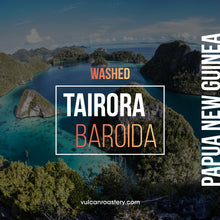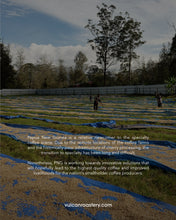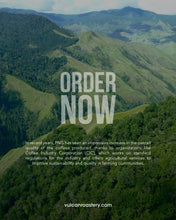PAPUA NEW GUINEA
TAIRORA - WASHED

FARM: Colbran Coffeelands Estate
VARIETAL: Arusha, Bourbon, Mundo Novo, Typica
PROCESSING: Washed
ALTITUDE: 1,700 to 1850 meters above sea level
PRODUCER: Various Farmers
REGION: Baroida, Eastern Highlands
TASTING NOTES: Blackberry, Monkfruit, Molasses
The Eastern Highlands benefit from a combination of ideal climatic conditions, rich soils, and growing attention and knowledge from small farmers to improve the quality of their coffees.

ABOUT THIS COFFEE
The cherry coffee is sold to the Baroida wet mill collection point on a daily basis during harvest and the cherry is sorted and checked for quality and the growers are paid on the spot for their cherry.
Meticulous separation for quality control helps maintain the high quality of the estate’s coffee. After careful sorting, cherry is pulped on disc pulpers. Then, it dry-ferments in vats for approximately 36 hours. Following fermentation, water is pumped into the vats in a circular motion to naturally agitate the coffee and remove any remaining mucilage. Coffee is sundried on tarps, where it is turned regularly to ensure even drying.
PNG’s unique grading system includes A, B, Y, Y2 and Y3 sizes. A is the highest quality grade and means a full, reasonably balanced, uniform, clean cup with a well-pronounced body and acidity, and a rich and distinct fragrance and aroma. A grade coffees have fewer than 10 defects per kilogram.
Papua New Guinea (PNG) is a relative newcomer to the specialty coffee scene. The remote locations of the nation’s smallholders—who produce 85% of total coffee in the country combined with historically poor infrastructure has made the transition to specialty difficult.
Nonetheless, the country is working towards innovative solutions in order to achieve better quality coffee and improved livelihoods for the nation’s smallholder coffee producers.
ABOUT (PNG) PAPUA NEW GUINEA
The introduction of coffee to Papua New Guinea is directly linked to the country’s colonial past. The first official record of coffee in the region is found in an 1890 colonial government report, right in the midst of Forsayth’s trading power. By 1897, Variarata, a plantation outside Port Moresby and a little northwest of Rigo, had planted 20,000 Arabica trees. Four years later, in 1901, shortly after the trees began to bear the cherries, the plantation began exporting to Australia. It was not until the late 1920s that business owners made a major effort to increase production to a commercial level.
Much of this growth is due to smallholder farmers in the highlands who benefit from a combination of ideal climatic conditions, rich soils and the growing attention and knowledge of smallholder farmers. It should be noted that in PNG it has been particularly difficult to organize farmers into cooperatives. This is in part due to the incredible diversity of tribals and languages.









